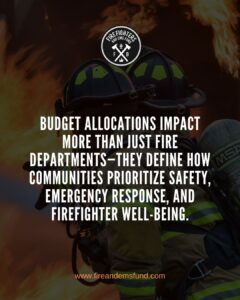In communities across America, fire departments face mounting challenges threatening their ability to protect the public. From aging equipment to chronic understaffing, many stations operate on razor-thin margins while responding to an ever-increasing volume of emergencies. As call volumes surge and operational costs rise, the gap between needs and resources widens, putting firefighters and communities at risk.
How Are States Allocating Firefighter Budgets in 2025?
State fire department funding has evolved significantly recently, with several states implementing innovative approaches to address critical needs. Over the past two months, we have seen positive developments in Tennessee and Massachusetts. Both States have recently announced significant investments in targeted state grants for fire departments.
Tennessee’s Volunteer Firefighter Equipment and Training Grant Program
Established in 2020 by the Tennessee State Fire Marshall’s Office, this grant exemplifies how targeted state grants for fire departments can strengthen emergency response capabilities in rural communities.
In the State of Tennessee, over 73% of the territory is covered by all-volunteer fire departments. This often means constant fundraising efforts to purchase the necessary equipment, especially in rural areas.
Since its inception, it has allocated over $26.5 million in grants across the State. Just last January, the State announced that 2025, it will allocate $10 million for 245 stations and departments in all three Grand Divisions.
Massachusetts’s FY25 Firefighter Safety Equipment Grant Program
Further north, Massachusetts has prioritized firefighter safety through a competitive grant program, enabling departments to upgrade crucial safety gear.
The FY25 Grant is open to every fire department in the State and awards approximately $5 million each year for new thermal imaging cameras, CO2 meters, and tracking systems. However, these funds cannot be used for equipment maintenance, leases, or vehicle purchases.
These state-level initiatives demonstrate a growing recognition of fire departments’ essential role in public safety. However, firefighter budget allocations vary widely by region, creating disparities in emergency response capabilities across jurisdictions.

Budget Challenges & The Need for More Funding
Despite recent funding increases, fire departments continue to face significant operational hurdles. The emergency responder budget in many communities falls short of meeting basic needs, leading to:
Staffing Shortages
Departments struggle to maintain adequate personnel levels, forcing many to operate below recommended standards. This shortage impacts response times and increases risks to both firefighters and civilians.
Equipment Concerns
Outdated equipment poses a particular challenge, especially regarding personal protective gear. Recent studies have identified PFAS chemicals in older firefighting equipment, contributing to elevated cancer rates among first responders. Wildfires in states like California have further highlighted the urgent need for modern protective gear and fire suppression tools.This health crisis has created additional financial pressure through increased health insurance costs and worker’s compensation claims.
Rising Operational Costs
Inflation and growing service demands have stretched fire department support bills to their limits. Many departments must choose between maintaining current operations and investing in necessary upgrades.
State Legislative Awareness: What Voters Should Know
Several crucial funding initiatives await voter consideration in April 2025. These proposals represent critical opportunities to strengthen local emergency services:
- A $6 million referendum aims to bolster Emergency Medical Services in Brookfield, Wisconsin
- An $11.6 million bond proposal to fund essential fire station improvements in Cedar Hill, Missouri
Taking Action for Our Fire Departments
The future of our fire services depends on informed, engaged citizens who understand the critical role of adequate funding in public safety. Every vote on fire department funding initiatives represents an investment in community protection and first responder safety. By staying involved in local politics and supporting necessary funding measures, citizens can help ensure their fire departments have the resources needed to protect lives and property effectively.
Remember that strong fire departments build safer communities: your voice and your vote matter in securing the future of emergency services in your area.








